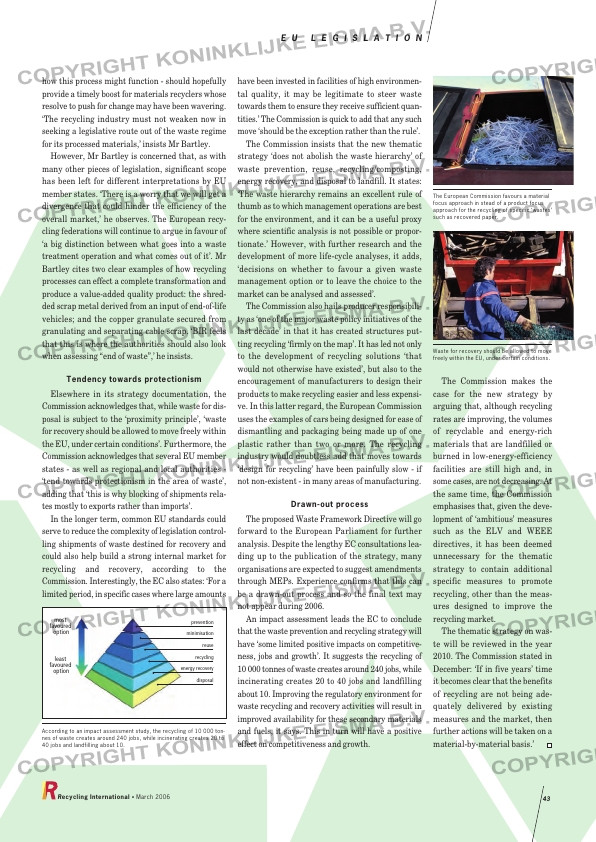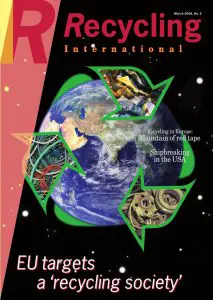Page 43 from: March 2006

how this process might function – should hopefully
provide a timely boost for materials recyclers whose
resolve to push for change may have been wavering.
‘The recycling industry must not weaken now in
seeking a legislative route out of the waste regime
for its processed materials,’ insists Mr Bartley.
However, Mr Bartley is concerned that, as with
many other pieces of legislation, significant scope
has been left for different interpretations by EU
member states. ‘There is a worry that we will get a
divergence that could hinder the efficiency of the
overall market,’ he observes. The European recy-
cling federations will continue to argue in favour of
‘a big distinction between what goes into a waste
treatment operation and what comes out of it’. Mr
Bartley cites two clear examples of how recycling
processes can effect a complete transformation and
produce a value-added quality product: the shred-
ded scrap metal derived from an input of end-of-life
vehicles; and the copper granulate secured from
granulating and separating cable scrap. ‘BIR feels
that this is where the authorities should also look
when assessing “end of waste”,’ he insists.
Tendency towards protectionism
Elsewhere in its strategy documentation, the
Commission acknowledges that, while waste for dis-
posal is subject to the ‘proximity principle’, ‘waste
for recovery should be allowed to move freely within
the EU, under certain conditions’. Furthermore, the
Commission acknowledges that several EU member
states – as well as regional and local authorities –
‘tend towards protectionism in the area of waste’,
adding that ‘this is why blocking of shipments rela-
tes mostly to exports rather than imports’.
In the longer term, common EU standards could
serve to reduce the complexity of legislation control-
ling shipments of waste destined for recovery and
could also help build a strong internal market for
recycling and recovery, according to the
Commission. Interestingly, the EC also states: ‘For a
limited period, in specific cases where large amounts
have been invested in facilities of high environmen-
tal quality, it may be legitimate to steer waste
towards them to ensure they receive sufficient quan-
tities.’ The Commission is quick to add that any such
move ‘should be the exception rather than the rule’.
The Commission insists that the new thematic
strategy ‘does not abolish the waste hierarchy’ of
waste prevention, reuse, recycling/composting,
energy recovery, and disposal to landfill. It states:
‘The waste hierarchy remains an excellent rule of
thumb as to which management operations are best
for the environment, and it can be a useful proxy
where scientific analysis is not possible or propor-
tionate.’ However, with further research and the
development of more life-cycle analyses, it adds,
‘decisions on whether to favour a given waste
management option or to leave the choice to the
market can be analysed and assessed’.
The Commission also hails producer responsibili-
ty as ‘one of the major waste policy initiatives of the
last decade’ in that it has created structures put-
ting recycling ‘firmly on the map’. It has led not only
to the development of recycling solutions ‘that
would not otherwise have existed’, but also to the
encouragement of manufacturers to design their
products to make recycling easier and less expensi-
ve. In this latter regard, the European Commission
uses the examples of cars being designed for ease of
dismantling and packaging being made up of one
plastic rather than two or more. The recycling
industry would doubtless add that moves towards
‘design for recycling’ have been painfully slow – if
not non-existent – in many areas of manufacturing.
Drawn-out process
The proposed Waste Framework Directive will go
forward to the European Parliament for further
analysis. Despite the lengthy EC consultations lea-
ding up to the publication of the strategy, many
organisations are expected to suggest amendments
through MEPs. Experience confirms that this can
be a drawn-out process and so the final text may
not appear during 2006.
An impact assessment leads the EC to conclude
that the waste prevention and recycling strategy will
have ‘some limited positive impacts on competitive-
ness, jobs and growth’. It suggests the recycling of
10 000 tonnes of waste creates around 240 jobs, while
incinerating creates 20 to 40 jobs and landfilling
about 10. Improving the regulatory environment for
waste recycling and recovery activities will result in
improved availability for these secondary materials
and fuels, it says. This in turn will have a positive
effect on competitiveness and growth.
Recycling International • March 2006 43
E U L E G I S L A T I O N
The European Commission favours a material
focus approach in stead of a product focus
approach for the recycling of specific ‘wastes’
such as recovered paper.
Waste for recovery should be allowed to move
freely within the EU, under certain conditions.
most
favoured
option
least
favoured
option
prevention
minimisation
reuse
recycling
energy recovery
disposal
According to an impact assessment study, the recycling of 10 000 ton-
nes of waste creates around 240 jobs, while incinerating creates 20 to
40 jobs and landfilling about 10.
The Commission makes the
case for the new strategy by
arguing that, although recycling
rates are improving, the volumes
of recyclable and energy-rich
materials that are landfilled or
burned in low-energy-efficiency
facilities are still high and, in
some cases, are not decreasing. At
the same time, the Commission
emphasises that, given the deve-
lopment of ‘ambitious’ measures
such as the ELV and WEEE
directives, it has been deemed
unnecessary for the thematic
strategy to contain additional
specific measures to promote
recycling, other than the meas-
ures designed to improve the
recycling market.
The thematic strategy on was-
te will be reviewed in the year
2010. The Commission stated in
December: ‘If in five years’ time
it becomes clear that the benefits
of recycling are not being ade-
quately delivered by existing
measures and the market, then
further actions will be taken on a
material-by-material basis.’
RI_050 EU Legislation 24-02-2006 09:49 Pagina 43



